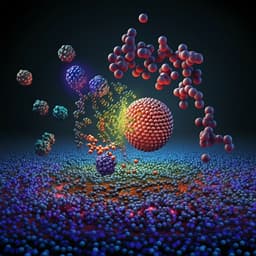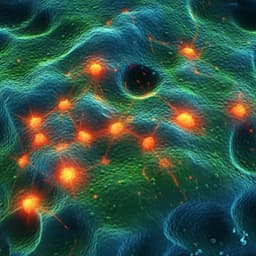
Chemistry
Highly efficient and selective electrocatalytic hydrogen peroxide production on Co-O-C active centers on graphene oxide
B. Zhang, T. Zheng, et al.
This innovative research conducted by Bin-Wei Zhang, Tao Zheng, Yun-Xiao Wang, Yi Du, Sheng-Qi Chu, Zhenhai Xia, Rose Amal, Shi-Xue Dou, and Liming Dai reveals a breakthrough in eco-friendly hydrogen peroxide synthesis through electrochemical oxygen reduction. The remarkable Co-O-C@GO active centers demonstrate high reactivity and selectivity, paving the way for practical applications in green chemistry.
~3 min • Beginner • English
Introduction
Hydrogen peroxide (H2O2) is a top-100 industrial chemical with widespread applications in chemical and pharmaceutical production, environmental protection, and energy technologies. Conventional H2O2 production via the anthraquinone process requires large-scale infrastructure, high temperature and pressure, and generates waste streams, motivating greener, decentralized approaches. Electrosynthesis of H2O2 via the two-electron oxygen reduction reaction (2e ORR) has attracted significant attention, yet practical deployment is limited by sluggish kinetics and low selectivity. Single-atom catalysts (SACs) offer high catalytic performance due to low coordination environments, but most SACs are stabilized on N-doped carbon, which often favors the four-electron ORR pathway to water, not ideal for H2O2 generation. Oxidized carbon materials containing oxygen functional groups (e.g., COOH, C-O-C) can catalyze 2e ORR, suggesting a strategy to combine SACs with oxygen-functionalized carbon supports to improve both activity and selectivity for H2O2 production. The authors propose anchoring single Co atoms onto graphene oxide (GO) to form Co-O-C active centers (Co1@GO), hypothesizing that synergistic interactions between O-bonded Co sites and adjacent oxygen functionalities will enhance 2e ORR kinetics and H2O2 selectivity.
Literature Review
Prior work shows: (1) SACs on N-doped carbons often promote the 4e ORR pathway to H2O, limiting H2O2 selectivity. (2) Oxidized carbon materials with oxygen functional groups such as COOH and C-O-C can act as defect-type sites that favor 2e ORR to H2O2 with good selectivity (e.g., oxidized carbon-catalyzed oxygen reduction to H2O2). (3) Engineering the coordination environment and proximal functional groups around single metal sites can tune ORR selectivity and activity. (4) Reports on various single-metal catalysts and carbon-based materials (e.g., Co-N-C, Fe-CNT, N-doped graphene) highlight trade-offs between onset potential and H2O2 selectivity. These insights motivate designing SACs anchored on oxygen-functionalized carbons to harness synergistic effects for improved 2e ORR performance.
Methodology
Synthesis of Co1@GO: A dispersion of 6.2 mg CoCl2 and 50 mg GO in ultrapure water was ultrasonicated for 30 min, freeze-dried for 48 h, then thermally treated at 300 °C for 2 h in 5 vol% H2 in N2 to form Co nanoparticles on GO (Co NPs/GO). Acid leaching in 2 M HCl for 24 h produced Co clusters/GO, followed by leaching in 2 M HNO3 for 24 h to remove clusters and yield atomically dispersed Co stabilized by GO oxygen groups (Co1@GO). The sample was collected by centrifugation and washed with water and ethanol. A GO control was prepared identically without CoCl2.
Structural characterization: HAADF-STEM confirmed the absence of Co nanoparticles/clusters and the presence of isolated Co atoms uniformly dispersed on GO. EDS verified Co presence. XRD showed only the GO peak (~24.9°), with no Co-related peaks. Raman (D at ~1342 cm−1, G at ~1587 cm−1) indicated retained GO structure. XPS (Co 2p, O 1s, C 1s) showed Co in high oxidation states (Co2+–Co3+) with Co–O bonding and oxygen functionalities (C-O-C, C-O-H, C=O). The C-O-C:C-O-H:C=O ratios increased from Co NPs/GO to Co1@GO (0.8:0.6:1 → 2.3:1.5:1). Oxygen contents: 12.3% (Co NPs/GO), 14.5% (Co clusters/GO), 15.3% (Co1@GO). Co loading was ~1.8% by ICP-OES. XAS (Co K-edge) indicated atomically dispersed Co coordinated with O; EXAFS showed a Co–O peak at 1.47 Å and no Co–Co peak, consistent with high oxidation states and a Co–O–C environment; fitting supported a Co–O3–C structure.
Electrochemical measurements: Performed in O2-saturated 0.1 M KOH at room temperature in a three-electrode RRDE setup (glassy carbon disk 5.0 mm diameter; Pt ring OD 7.5 mm, ID 6.5 mm). Catalyst inks: 5.0 mg catalyst in 50 µL Nafion + 950 µL ethanol, sonicated 1 h; 5 µL deposited on disk. Potentials referenced to RHE via E(RHE)=E(SCE)+0.224 V+0.0592 pH. LSV at 10 mV s−1, rotation 1600 rpm; ring held at 1.5 V vs RHE to oxidize H2O2. H2O2 selectivity, productivity, and electron transfer number were calculated using standard RRDE equations with ring collection efficiency N=0.26. Stability tested by chronoamperometry at constant potential (reported 36,000 s data). Bulk H2O2 production measured in an H-cell with 0.5 mg cm−2 Co1@GO on a 2×2 cm2 GDL as cathode, Pt anode, and an anion exchange membrane; H2O2 quantified colorimetrically via Ce(SO4)2 at 320 nm.
Computational methods: DFT calculations with VASP using PAW-PBE, spin polarization, plane-wave cutoff 550 eV, Monkhorst-Pack 3×3×1 k-point mesh. Models: single-layer graphene with embedded Co–O structures (cell ~12.82×12.34×20.06 Å). Structures fully relaxed to forces <0.01 eV Å−1. Implicit solvation (VASPsol) used to simulate aqueous environment; DFT+U applied for Co 3d. Free energy diagrams, overpotentials, density of states, Bader charges computed for candidate Co–O–C motifs (e.g., Co–O3–C, Co–O4–C).
Key Findings
- Structure and active site: Co1@GO contains atomically dispersed Co coordinated to oxygen on GO, forming Co–O–C centers with a Co–O bond length of 1.47 Å and high Co oxidation state (+2 to +3). No Co–Co coordination is detected (EXAFS). Co loading is ~1.8%. XPS shows increased C–O–C content and evidence for a Co–O–C conjugated complex.
- ORR performance (0.1 M KOH, O2-saturated, RRDE, 1600 rpm): Co1@GO exhibits an onset potential of 0.91 V vs RHE and diffusion-limited disk current ~0.5 mA, outperforming GO (0.68 V, 0.028 mA), Co NPs/GO (0.81 V, 0.34 mA), and Co clusters/GO (0.76 V, 0.19 mA). H2O2 selectivity at 0.6 V: 81.4% (Co1@GO) vs 76.3% (GO) and 68.7% (Co NPs/GO). H2O2 productivity at 0.50 V: 1.0 mg cm−2 h−1 for Co1@GO, which is 19× GO (0.052 mg cm−2 h−1) and ~2× Co NPs/GO (0.55 mg cm−2 h−1). Electron transfer numbers are in the 2.3–2.7 range across 0.4–0.7 V, with Co1@GO at the lower end, indicating a dominant 2e pathway.
- Two-electrode H-cell: Co1@GO delivers steady-state H2O2 at 0.76 V with production rates of ~5.7 mol g−1 h−1 or 28 mol m−2 h−1.
- Stability: Over 36,000 s, Co1@GO maintains disk and ring currents of ~0.32 mA and 0.024 mA, respectively, representing ~40× (disk) and ~3.6× (ring) those of GO under identical conditions.
- Mechanism and theory: DFT identifies Co–O3–C as the most probable active center with favorable formation energy (−2.78 eV). The 2e ORR pathway to H2O2 exhibits a very low overpotential (~0.06 V) and near-ideal free energy profile, whereas the 4e pathway shows a high overpotential (~1.07 V) with OH* desorption as the limiting step due to strong OH* binding. The presence of O-bonded Co and adjacent C–O groups lowers the OOH* free energy (by ~0.06 eV), enhancing 2e ORR kinetics. Alternative Co–O4–C motifs may also be active for 2e ORR (e.g., Co–O4–C-(OH)4 with 0.01 V 2e overpotential), but exhibit electronic features that can hinder electron transfer compared to Co–O3–C. Overall, Co1@GO combines high activity, selectivity, and stability and compares favorably in onset potential and selectivity against reported H2O2 electrocatalysts.
Discussion
The study addresses the core challenge of sluggish kinetics and low selectivity in electrochemical H2O2 production by designing a Co–O–C active center on oxygen-functionalized GO. Anchoring single Co atoms in a high oxidation state onto GO creates a synergistic interaction with neighboring oxygen groups, forming an electron-conjugated Co–O–C complex that optimizes intermediate binding. Experimentally, this translates into a more positive ORR onset potential, higher H2O2 selectivity, and substantially increased H2O2 productivity compared to GO and Co nanoparticle counterparts. The RRDE data confirm a dominant 2e ORR pathway (n ≈ 2.3–2.7) and strong durability. DFT corroborates the mechanistic basis: the Co–O3–C site favors the 2e pathway with a minimal overpotential, while the 4e route is impeded by strong OH* adsorption. The lowered free energy for OOH* formation on Co1@GO rationalizes the observed improved onset potential and activity. Collectively, the results validate the hypothesis that coupling single metal atoms with oxygen functionalities on carbon supports can tune ORR selectivity towards H2O2 while enhancing kinetics and stability, providing a promising route for practical, green H2O2 electrosynthesis.
Conclusion
Single-atom Co anchored on graphene oxide (Co1@GO) forms Co–O–C active centers that deliver high-performance 2e ORR to H2O2, achieving a 0.91 V onset potential, ~81% H2O2 selectivity (at 0.6 V), and 1.0 mg cm−2 h−1 productivity (at 0.50 V), with robust stability and favorable performance in a two-electrode cell. Spectroscopic evidence (XAS/EXAFS, XPS) and DFT calculations identify Co–O3–C as a key catalytic motif, where synergistic interactions between O-bonded Co and adjacent oxygen groups optimize intermediate binding and suppress the 4e pathway. This work introduces a rational strategy for designing efficient, selective, and stable electrocatalysts for H2O2 production and suggests broader applicability of oxygen-functionalized carbon supports in single-atom catalysis for other electrochemical reactions. Future research may explore tuning oxygen functionality and Co coordination, operation across different electrolytes and pH, scaling electrode architectures, and long-term durability under practical operating conditions.
Limitations
The paper does not explicitly state limitations. Reported performance is demonstrated in O2-saturated 0.1 M KOH; behavior in other electrolytes and pH regimes is not shown. Stability is evidenced over 36,000 s (~10 h); longer-term durability and scale-up are not evaluated. Active-site assignments rely on a combination of XAS/EXAFS fitting and DFT modeling rather than direct in situ/operando identification under reaction conditions.
Related Publications
Explore these studies to deepen your understanding of the subject.







